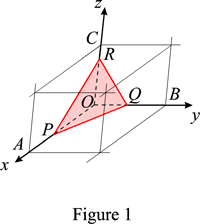Difference between revisions of "Miller indices"
From Online Dictionary of Crystallography
(→See also) |
(→Direct space: reformultated to specifiy that the indices are resctricted to co-prime integers only when a primitive basis is used) |
||
| Line 6: | Line 6: | ||
=== Direct space === | === Direct space === | ||
| − | + | The [[law of rational indices]] states that the intercepts, ''OP'', ''OQ'', ''OR'', of the natural faces of a crystal form with the basis vectors ''OA''' = '''a''', '''OB''' = '''b''', and '''OC''' = '''c''' are inversely proportional to prime integers, ''h'', ''k'', ''l'', called '''Miller indices''' of the face. This definition can be extended to any reticular plane whose intercepts with the basis vectors are ''OP = C a/h'', ''OQ = C b/k'', and ''OR = C c/l'' (see Figure 1). When the lattice is indexed with respect to a [[primitive basis]], ''h'', ''k'', ''l'' are co-prime integers; this restriction does not hold instead when a [[Centred_lattices|centred unit cell]] is chosen. ''C'' is an integer which, when made variable, identifies a specific lattice plane of the infinite set having the same orientation with respect to the basis vector. This infinite set of planes defines a ''family'' of lattice planes, denoted by the Miller indices in parentheses: (''hkl''). The Miller indices of the equivalent faces of a [[crystal form]] are denoted by {''hkl''}. | |
| + | The variation of the orientation of the planes with the ratios of the Miller indices is illustrated in the attached [[Miller_Examples| examples]]. The equation of the planes of the family is: | ||
<center> | <center> | ||
Revision as of 14:01, 25 January 2016
Indices de Miller (Fr.). Indices de Miller (Sp). Indici di Miller (It). ミラー指数 (Ja)
Contents
Definition
Direct space
The law of rational indices states that the intercepts, OP, OQ, OR, of the natural faces of a crystal form with the basis vectors OA' = a, OB = b, and OC = c are inversely proportional to prime integers, h, k, l, called Miller indices of the face. This definition can be extended to any reticular plane whose intercepts with the basis vectors are OP = C a/h, OQ = C b/k, and OR = C c/l (see Figure 1). When the lattice is indexed with respect to a primitive basis, h, k, l are co-prime integers; this restriction does not hold instead when a centred unit cell is chosen. C is an integer which, when made variable, identifies a specific lattice plane of the infinite set having the same orientation with respect to the basis vector. This infinite set of planes defines a family of lattice planes, denoted by the Miller indices in parentheses: (hkl). The Miller indices of the equivalent faces of a crystal form are denoted by {hkl}. The variation of the orientation of the planes with the ratios of the Miller indices is illustrated in the attached examples. The equation of the planes of the family is:
hx + ky + lz = C
Reciprocal space
The reciprocal lattice vector associated to the family of lattice planes is OH = h a* + k b* + l c*, where a*, b*, c* are the reciprocal lattice basis vectors. OH is perpendicular to the family of lattice planes and OH = 1/d where d is the lattice spacing of the family.
Bravais-Miller indices (hexagonal axes)
In the case of an hexagonal lattice, one uses four axes, a1, a2, a3, c and four indices, (hkil), called Bravais-Miller indices, where h, k, i, l are again inversely proportional to the intercepts of a plane of the family with the four axes. The indices h, k, i are cyclically permutable and are related by
h + k + i = 0
Behaviour in a change of basis
In a change of basis the Miller indices h, k, l transform like the basis vectors a, b, c and are for that reason covariant quantities.
Rhombohedral crystals
The Miller indices hR, kR, lR referred to rhombohedral axes are related to the corresponding indices, hH, kH, iH,lH reffered to hexagonal axes by:
| hH = kR - lR | ; | hR = ⅓(- kH + iH + lH) |
| kH = lR - hR | ; | kR = ⅓(hH - iH + lH) |
| iH = hR - kR | ; | lR = ⅓(- hH + kH + lH) |
| lH = hR + kR + lR |
Example
Orientation of lattice planes depending on their Miller indices
The Miller indices of the planes ABC' , ABC, ABC" , AA"BB" are (112) , (111), (221), (110), respectively. These planes have AB , or [math] [1{\bar 1}0][/math], as common zone axis.
History
The Miller indices were first introduced, among others, by W. Whewell in 1829 and developed by W.H. Miller, his successor at the Chair of Mineralogy at Cambridge University, in his book A treatise on Crystallography (1839) - see Historical Atlas of Crystallography (1990), edited by J. Lima de Faria, published for the International Union of Crystallography by Kluwer Academic Publishers, Dordrecht.

